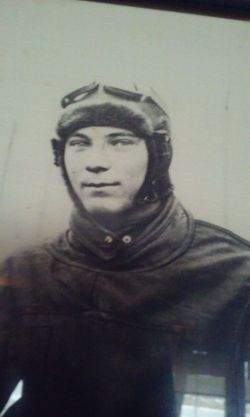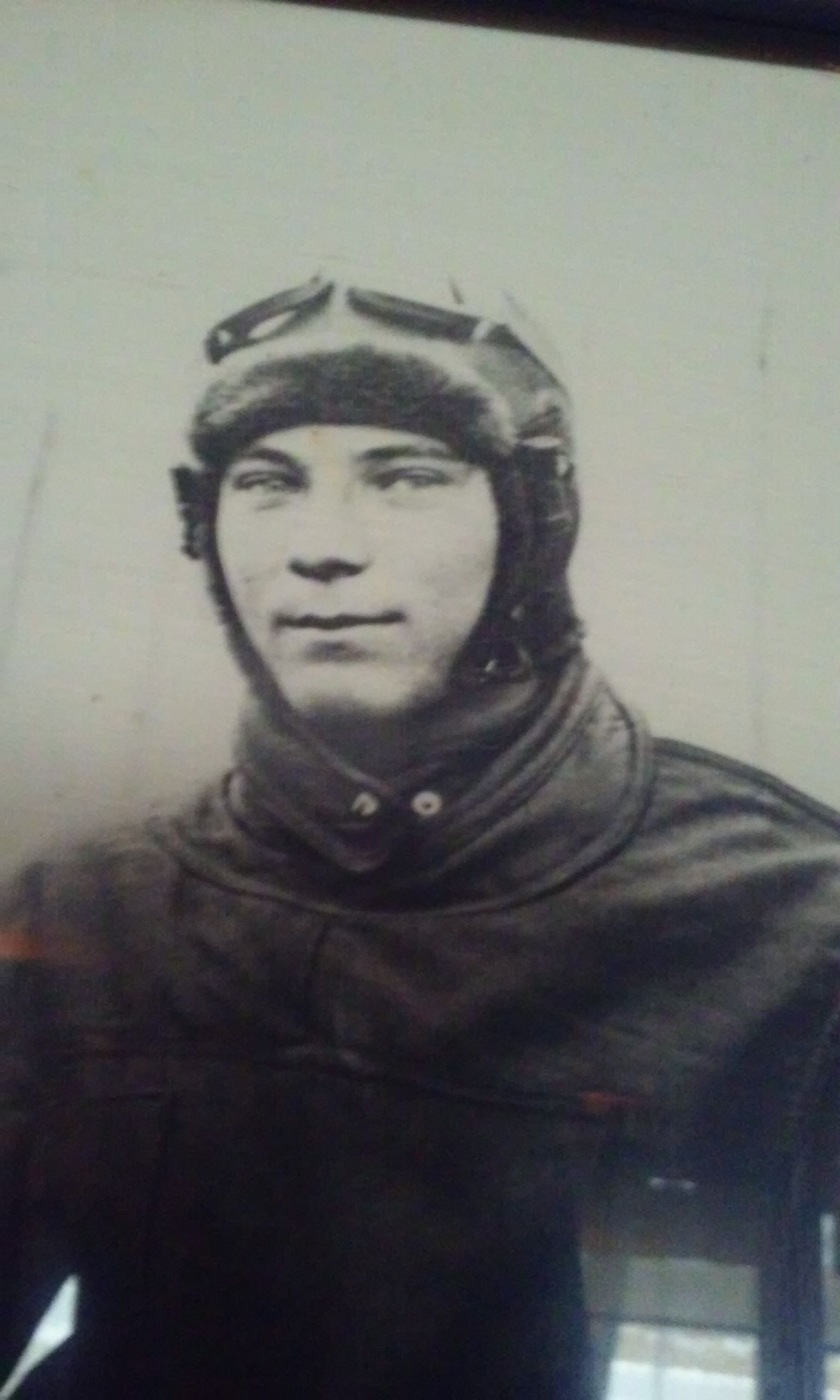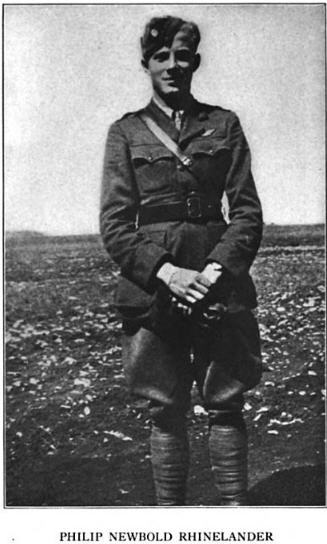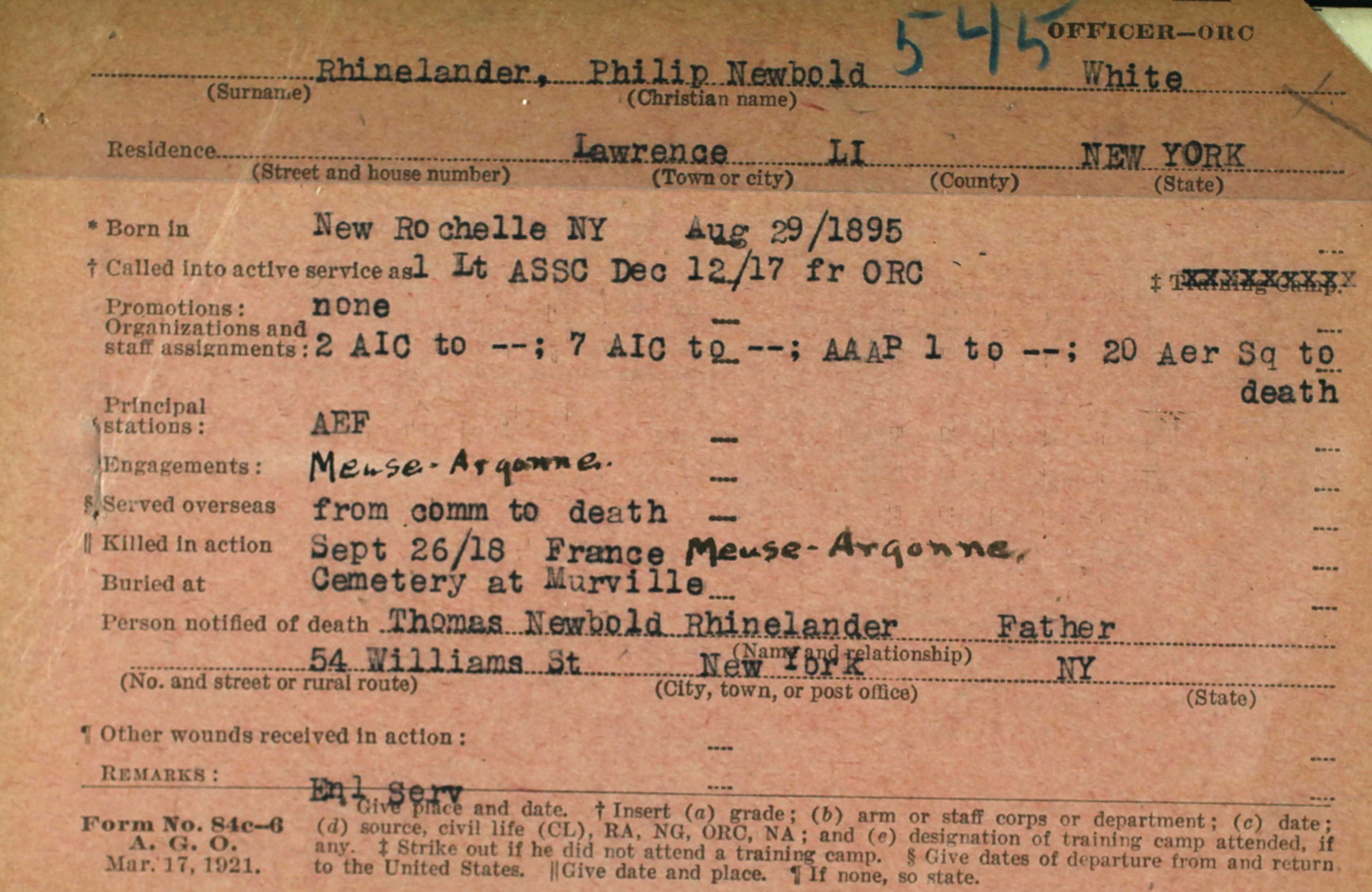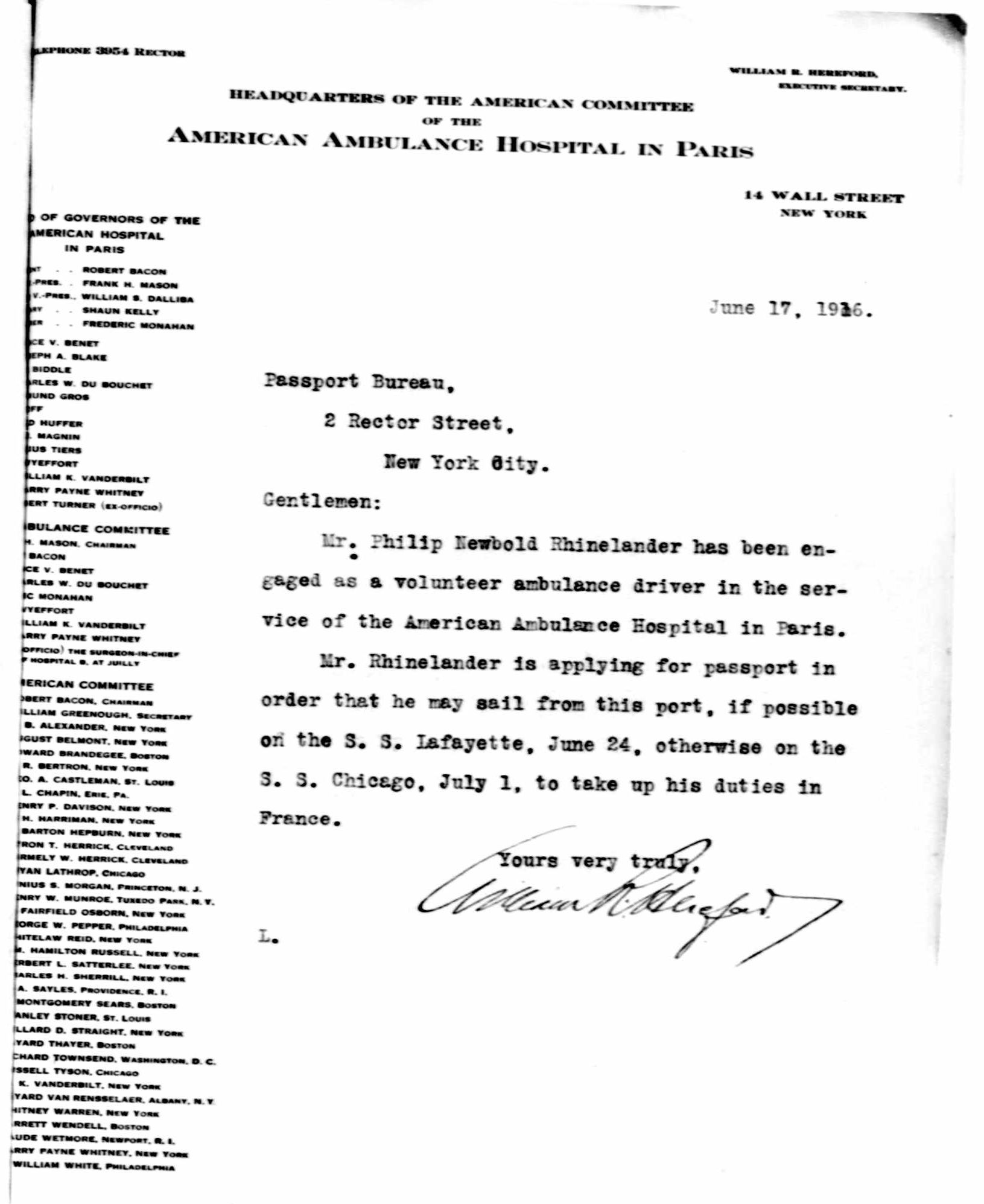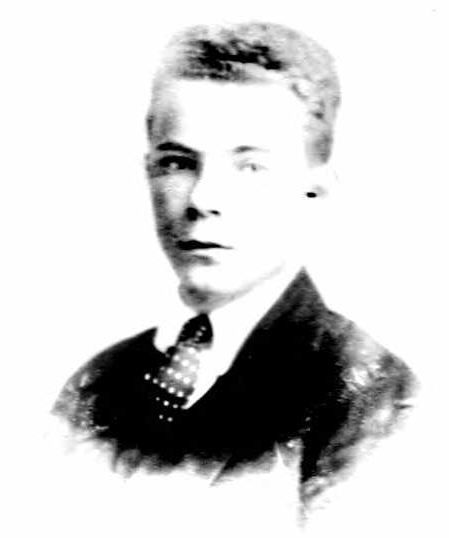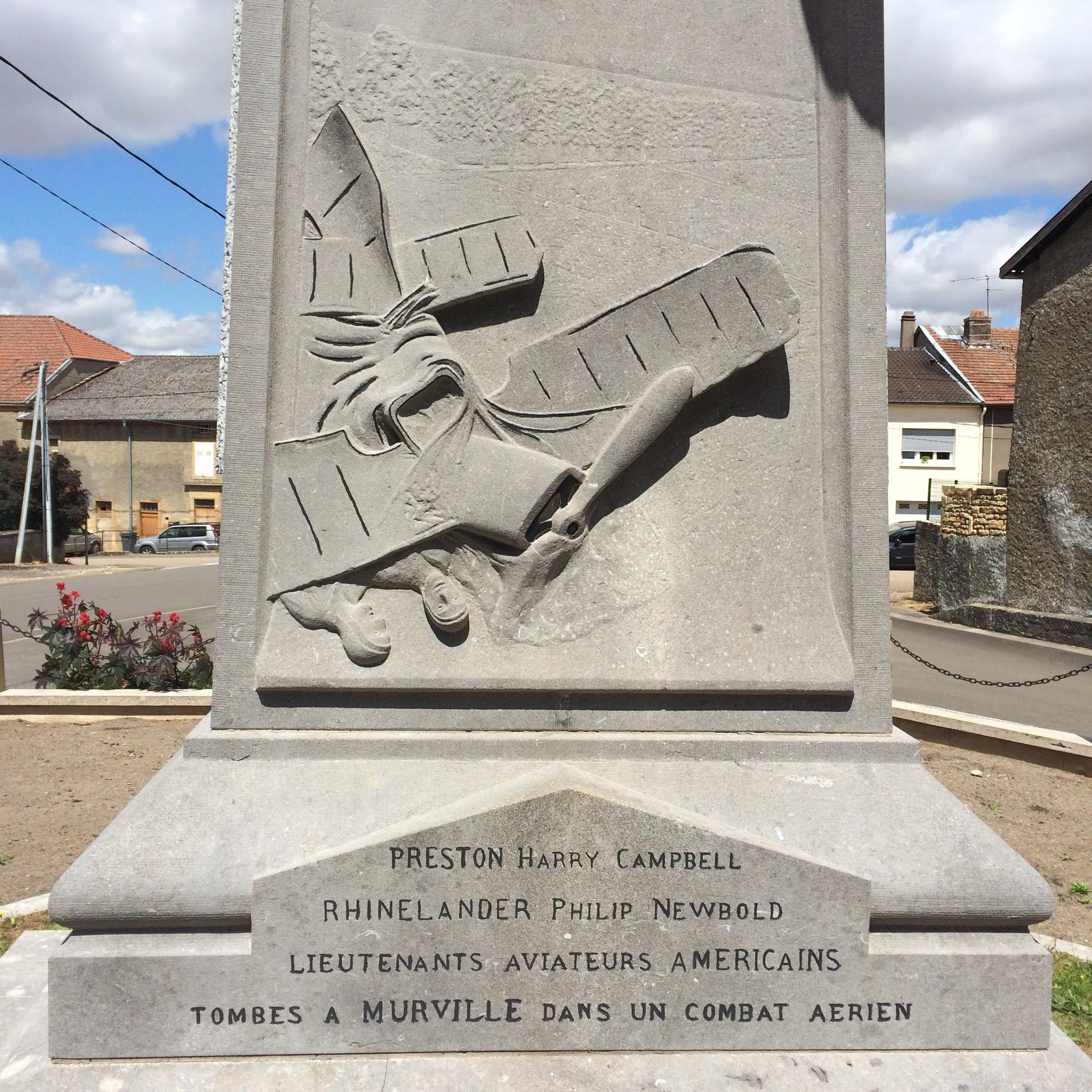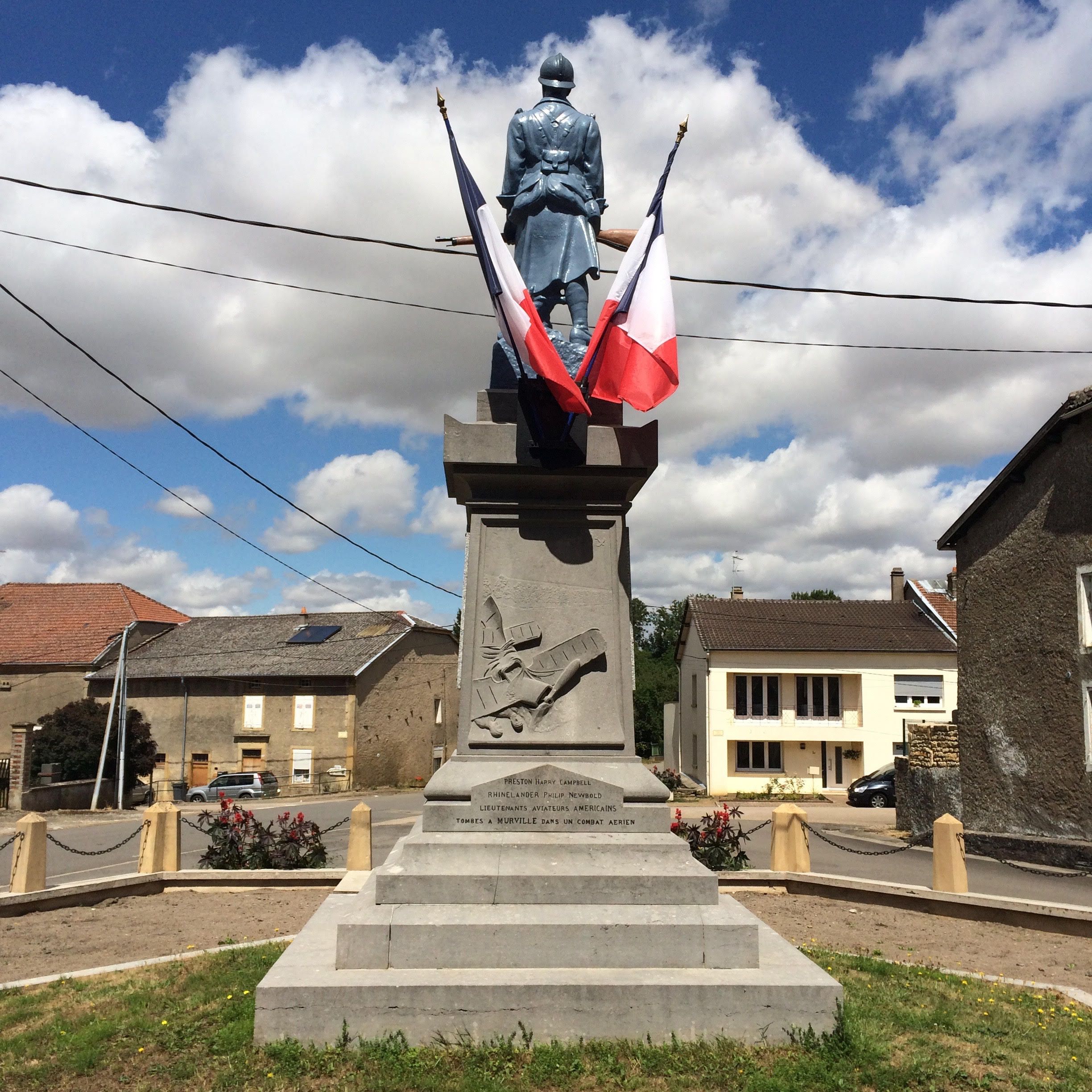-----------------------
Pilot, shot down during aerial combat in France, falling to his death.
Born August 29, 1895. Son of Thomas Newbold and Katherine Rhinelander. Home, Lawrence, Long Island, New York. Educated St. George's School, Newport, Rhode Island; Thatcher School, California, and Harvard University, Class of 1918. Joined American Field Service, July 11, 1916; attached Section Nine in France and Ten in Albania until July 16, 1917. Enlisted U. S. Aviation.
First Lieutenant, November, 1917. Trained Tours and Clermont-Ferrand; attached 20th Day Bombing Squadron. Killed in combat, September 26, 1918, at Murville, over German lines southeast of Longuyon, near Audun-le-Roman. Buried Murville, Meurthe-et-Moselle.
PHILIP RHINELANDER, with his boyish spirit, and his charm, the embodiment of a fine inheritance, was always a favorite in whatever group he mingled. Courteous and thoughtful of others but always with a playful smile on his lips, he won the affection, admiration, and confidence of everyone who knew him. Life seemed to hold everything for him, and yet one knows instinctively that he faced death with that same playful smile hovering about his lips.
On September 26, 1918, the first day of the great Argonne offensive, the Twentieth Aero Squadron, of the First Bombardment Group, was ordered to bomb, by daylight and at all costs, the railway bridge at Dun-sur-Meuse north of Verdun. Fourteen aviators crossed the lines to carry out this mission. "Phil" Rhinelander was one of the eleven who never came back.
It was"Phil's" first trip over the lines. He was piloting a DH4 bombing plane equipped with a Liberty motor. Near the village of Dun the flight to which he belonged beat off an equal number of Boche avions, and over Longuyon was again attacked, this time by about twenty German pursuit planes of the famous Richthofen Squadron, and a running "cat-and-dog fight" ensued.
"We lost most of our best men," wrote Lieutenant Sidney Howard, the Flight Leader, "among them Rhinelander . . . . . .. And Lieutenant Clarkson Potter, who was, decorated with the D. S. C. for his part in this raid, and later himself shot down and killed in aerial, combat, wrote in a letter home: "Several times during the fight I saw Rhinelander and Preston blazing away with their guns as fast as they could fire." An intelligence officer attached to the Air Service of the Fifth German Army has described the onrush of the Richthofen "Fokkers," and writes:
"In the ensuing general fight three Americans, who probably wanted to cover the retreat of the others, were cut off. One of these was Rhinelander . . . . . Three to five German planes pounced upon each of these, separated from the rest, in order to force them to land or to shoot them down. The three Americans put up a bitter fight and gave us hard work. The hopeless fight may have lasted ten minutes. The numerical superiority of the Germans, and their fighting routine, overcame their young adversaries." French eye-witnesses agreed that there were five Boche avions attacking his plane when "Phil" fell.
Rhinelander left Harvard to join the Field Service in the summer of 1916 and he remained with it as a volunteer for more than a year. He was at first attached to Section Nine, then working in the mountains of Alsace Reconquise. Afterwards he was one of those who volunteered to make up Section Ten, which was being sent out, at the especial request of French Headquarters, to work with the French troops in the Balkans. He returned to France in the summer of 1917 and enlisted in the American Air Service, receiving his preliminary training at Tours and his finishing training as a bombing pilot at Clermont-Ferrand.
The many friends "Phil" made during the war were not confined to his own countrymen. His bubbling gaiety endeared him as well to the French soldiers and officers with whom he came in contact. It was as impossible not to feel attracted by his eagerness, liveliness, and grace as it was not to admire his intense loyalty and his unfailing anxiety to do his best. He fell to his death that day, close to the pre-war boundary of German Alsace-Lorraine, with the same high, finely-tempered spirit with which he had faced every experience that devotion to duty had brought him.
"In 1916, [Edith] Wharton's young relative Philip Newbold Rhinelander joined the American ambulance corps in France. She wrote to his father, "I am so glad you have given him this opportunity of seeing this great moment of history, and lending a hand in the cause. I agree with you that such an experience ought to last throughout life, and I am sure Newbold is the kind to make the most of it."
But Newbold's experience didn't last long. When the U.S. entered the war in 1917, he joined the Army Air Corps and was killed during his first sortie, at the age of 23. His plane was shot down by a squadron commanded by 25-year-old Hermann Göring, the future Nazi leader." -- Wall Street Journal, Edith Wharton Goes to War by Anne Nelson, 11 August 2023
-----------------------
Pilot, shot down during aerial combat in France, falling to his death.
Born August 29, 1895. Son of Thomas Newbold and Katherine Rhinelander. Home, Lawrence, Long Island, New York. Educated St. George's School, Newport, Rhode Island; Thatcher School, California, and Harvard University, Class of 1918. Joined American Field Service, July 11, 1916; attached Section Nine in France and Ten in Albania until July 16, 1917. Enlisted U. S. Aviation.
First Lieutenant, November, 1917. Trained Tours and Clermont-Ferrand; attached 20th Day Bombing Squadron. Killed in combat, September 26, 1918, at Murville, over German lines southeast of Longuyon, near Audun-le-Roman. Buried Murville, Meurthe-et-Moselle.
PHILIP RHINELANDER, with his boyish spirit, and his charm, the embodiment of a fine inheritance, was always a favorite in whatever group he mingled. Courteous and thoughtful of others but always with a playful smile on his lips, he won the affection, admiration, and confidence of everyone who knew him. Life seemed to hold everything for him, and yet one knows instinctively that he faced death with that same playful smile hovering about his lips.
On September 26, 1918, the first day of the great Argonne offensive, the Twentieth Aero Squadron, of the First Bombardment Group, was ordered to bomb, by daylight and at all costs, the railway bridge at Dun-sur-Meuse north of Verdun. Fourteen aviators crossed the lines to carry out this mission. "Phil" Rhinelander was one of the eleven who never came back.
It was"Phil's" first trip over the lines. He was piloting a DH4 bombing plane equipped with a Liberty motor. Near the village of Dun the flight to which he belonged beat off an equal number of Boche avions, and over Longuyon was again attacked, this time by about twenty German pursuit planes of the famous Richthofen Squadron, and a running "cat-and-dog fight" ensued.
"We lost most of our best men," wrote Lieutenant Sidney Howard, the Flight Leader, "among them Rhinelander . . . . . .. And Lieutenant Clarkson Potter, who was, decorated with the D. S. C. for his part in this raid, and later himself shot down and killed in aerial, combat, wrote in a letter home: "Several times during the fight I saw Rhinelander and Preston blazing away with their guns as fast as they could fire." An intelligence officer attached to the Air Service of the Fifth German Army has described the onrush of the Richthofen "Fokkers," and writes:
"In the ensuing general fight three Americans, who probably wanted to cover the retreat of the others, were cut off. One of these was Rhinelander . . . . . Three to five German planes pounced upon each of these, separated from the rest, in order to force them to land or to shoot them down. The three Americans put up a bitter fight and gave us hard work. The hopeless fight may have lasted ten minutes. The numerical superiority of the Germans, and their fighting routine, overcame their young adversaries." French eye-witnesses agreed that there were five Boche avions attacking his plane when "Phil" fell.
Rhinelander left Harvard to join the Field Service in the summer of 1916 and he remained with it as a volunteer for more than a year. He was at first attached to Section Nine, then working in the mountains of Alsace Reconquise. Afterwards he was one of those who volunteered to make up Section Ten, which was being sent out, at the especial request of French Headquarters, to work with the French troops in the Balkans. He returned to France in the summer of 1917 and enlisted in the American Air Service, receiving his preliminary training at Tours and his finishing training as a bombing pilot at Clermont-Ferrand.
The many friends "Phil" made during the war were not confined to his own countrymen. His bubbling gaiety endeared him as well to the French soldiers and officers with whom he came in contact. It was as impossible not to feel attracted by his eagerness, liveliness, and grace as it was not to admire his intense loyalty and his unfailing anxiety to do his best. He fell to his death that day, close to the pre-war boundary of German Alsace-Lorraine, with the same high, finely-tempered spirit with which he had faced every experience that devotion to duty had brought him.
"In 1916, [Edith] Wharton's young relative Philip Newbold Rhinelander joined the American ambulance corps in France. She wrote to his father, "I am so glad you have given him this opportunity of seeing this great moment of history, and lending a hand in the cause. I agree with you that such an experience ought to last throughout life, and I am sure Newbold is the kind to make the most of it."
But Newbold's experience didn't last long. When the U.S. entered the war in 1917, he joined the Army Air Corps and was killed during his first sortie, at the age of 23. His plane was shot down by a squadron commanded by 25-year-old Hermann Göring, the future Nazi leader." -- Wall Street Journal, Edith Wharton Goes to War by Anne Nelson, 11 August 2023
Family Members
Sponsored by Ancestry
Advertisement
Records on Ancestry
Advertisement
